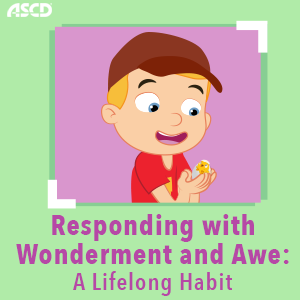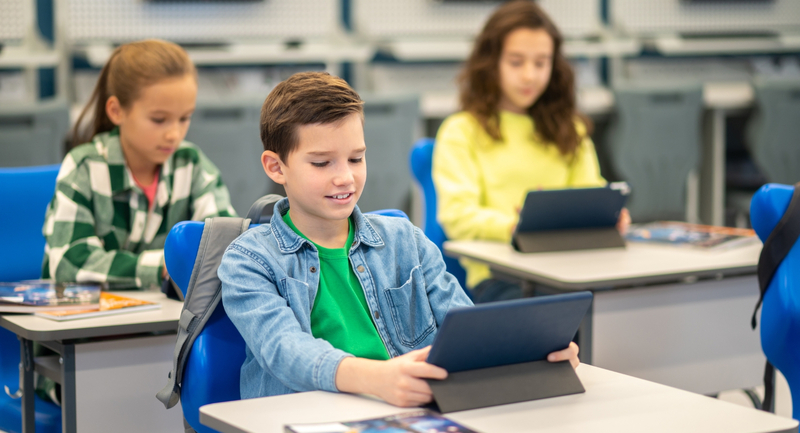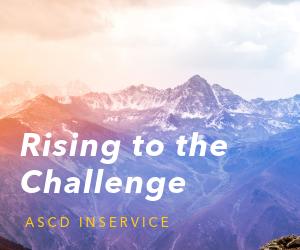This blog post is part of an ASCD partnership with Wonder Media. To see all blog posts from Wonder Media on the 16 Habits of Mind, you can click here.
“The most beautiful experience in the world is the experience of the mysterious.”
-Albert Einstein
Have you ever witnessed a young child react to the to a magician’s sleight of hand, or exclaim in delight over the appearance of a rainbow in the sky? Are you still thrilled at the sights and sounds of a fireworks display? As human beings, we have tremendous capacity to wonder and express awe for the world around us. Children, most of all, have great ability to see the world with excited and amazed eyes. This Habit of Mind, Responding with Wonderment and Awe, is described by Art Costa and Bena Kallick as the habit of finding the world awesome and mysterious, and of being intrigued with phenomena and beauty. When the world around us sparks our interest and ignites our sense of wonder, we are inspired to learn, to explore, to imagine possibilities. How can we, as teachers, as educational leaders, provide experiences that trigger that sense of amazement for our students to help them develop a lifelong habit of responding with wonderment and awe?
As a lower school principal, I have the frequent pleasure of witnessing the spontaneous delight students have when they are excited by something they are learning. While visiting classrooms, attending events, or just being among students at lunch, I have the privilege of being a sounding board for the stories and anecdotes students are most excited to tell.
“Guess what we did in science today?”
“Did you know that a hummingbird weighs less than a penny?”
“Today we learned that Russia has a greater surface area than Pluto!”
“Do you know what a googolplex is?”
When students approach me with amazement in their new knowledge, I can hear the awe in their voices for all there is to learn about the world and I ask myself, “How can we inspire such excitement every day? How can we identify the best vehicles to facilitate student learning by fostering wonder and awe in our classrooms?
Some of the true experts in fostering a habit of responding with wonderment and awe are early childhood and primary grade teachers. Teachers of our youngest learners fill their classroom spaces with materials and explorations that allow students to experiment, puzzle and figure out how things work, see what they can create and learn to do, and find answers to questions they are curious about. Young students ask so many questions and have such natural responses to their world that they provide outstanding models for what true wonder and awe looks like. It’s our job to foster those responses and build on the wonder students feel so we can help them develop the habit of responding with excitement and wonder when they encounter new ideas or surprising information.
Science and nature offer many provocations for learning that will motivate students to ask questions and seek answers. Animal behavior, plant growth, weather, ocean life, and chemical reactions are just a few examples of topics that can be springboards for deep exploration and learning when paired with thoughtful planning and presentation. Connecting science studies with a school garden that includes experimentation and problem solving can result in a complex understanding of and fascination with plant life and the wonders of earth science.
Working with patterns, equations and math phenomena is another pathway to building the habit of Responding with Wonderment and Awe. Math concepts like the sequence of Fibonacci numbers, and how this sequence appears in nature, prime spirals, or tessellations and art are other examples of fascinating content that can inspire wonder and promote further inquiry and discovery for students.
At a school wide level, the documentation of the learning process and the sharing of excitements and discoveries across grade levels and between different classrooms helps to model and foster the wonder and awe found through learning. By using Harvard Graduate School of Education’s visible thinking routines like See, Think, Wonder, Options Explosion, or Peeling the Fruit, we can help students understand the power of shared thinking, collaboration and reflection and how it can spark interest and excitement in others.
Most importantly, teachers who model wonderment and awe, who delight in learning with their students, and who share their own sense of amazement as they uncover and develop new knowledge and connections can make great strides in developing life-long learners and curious students who will respond with wonder and awe to the world in which they live. As educators, we have the benefit of seeing the world through children’s eyes, reminding us to pay attention to the many incredible happenings and mysteries around us. It’s our job to share the joy of childhood and help our students share it too!
Kathleen Malanowski has been an elementary educator and school administrator for over 25 years. She is passionate about teaching and learning and loves being a Lower School Principal. Kathleen works with teachers and students to develop a school-wide culture centered around thinking and learning through a collaborative and supportive school environment. Follow her on twitter at @NBPSLower








